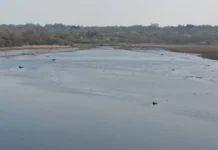By Jonathan Williams
Well it’s not exactly, it’s called Loughor Viaduct and it is being replaced by Network Rail as part of the £40 million improvements being implemented on the line.
£18.5 million of the project will go on dismantling the current the grade two listed viaduct, building a new one and then sliding it into place!
The current structure which is listed in its entirety as “a rare surviving example of a working timber viaduct” will be replaced in Easter 2013.
The investment will also see six miles of double track laid between Cockett West Junction and Duffryn West Junction and the re-instatement of the disused platform at Gowerton station. The replacement of the viaduct is needed as it can only bear the weight of one train at a time and offers the line the opportunity to go back to double track. It has been single track since 1986.
The new viaduct will be able to provide extra trains between Swansea and Llanelli and help current trains achieve greater reliability.
Improvement to services
Network Rail route managing director for Wales, Mark Langman said:
“Replacing the Loughor Viaduct is the key to improving rail services to West Wales and we’re keen to get on with the work on this vital link.”
“We appreciate the need to preserve our industrial heritage, we also have to provide the people of Wales with the best railway possible. In this instance we are working hard to keep some of the structure in place, whilst also taking care of the natural environment of the Loughor Estuary.”
“The improvements to the railway between Llanelli and Swansea won’t just allow for more trains, they will also make the existing services more reliable and give the economy of the area a welcome boost.”
Environment
Network Rail are also working closely with the Environment Agency for Wales and the Countryside Council for Wales as the Loughor Estuary is a site of special scientific interest. They aim to minimise the impact on the environment and protect wildlife, by taking away all of the spoil rather than pump it back into the water.
How are they going to do it?
Two platforms will be installed on either side of the bridge to effectively turn the structure into a quayside allowing a barge to be floated up the estuary to tie up next to the bridge. Another barge will be lowered in from the other side of the bridge. These will then sink pilings into the bed of the estuary so construction can continue around the operating railway.
To see more information and their monthly schedule, click here.
What will happen to the existing viaduct?
Samantha Rivers, Community Relations Advisor said:
“4 of the timber trestles will remain in situ (3 at the west end and 1 at the east end) and we are also constructing a monument on the west shore consisting of 3 trestles and 2 deck spans.”
“Additionally some of the remaining timber will be reused on the new structure, if possible, as fenders fitted to the new piles.”
“We are currently looking into other potential uses for the timber and are in the early stages of discussing these with local organisations that have shown an interest.”
Loughor Viaduct Key Info
- existing viaduct constructed in 1852 (timber),
- consisting of eighteen 12m (40ft) wide spans, supporting two lines. Seventeen fixed spans with a swing bridge at the Swansea end of the viaduct;
- over 200m in length.
- Superstructure replaced in 1908-09
- Timber trestles renewed/strengthened in 1979-81
- Single lined in 1986 (one line removed)
- Grade II listed as it is one of relatively few viaducts with timber sub-structure that is still in use on a mainline railway
- 1998 listing description suggested Brunel, updated in 2002 and 2008 (reference to Brunel under the reason for listing removed, although Brunel still identified as the Engineer under the section describing the history of the viaduct).
Picture: Network Rail information
Help keep news FREE for our readers
Supporting your local community newspaper/online news outlet is crucial now more than ever. If you believe in independent journalism, then consider making a valuable contribution by making a one-time or monthly donation. We operate in rural areas where providing unbiased news can be challenging. Read More About Supporting The West Wales Chronicle























